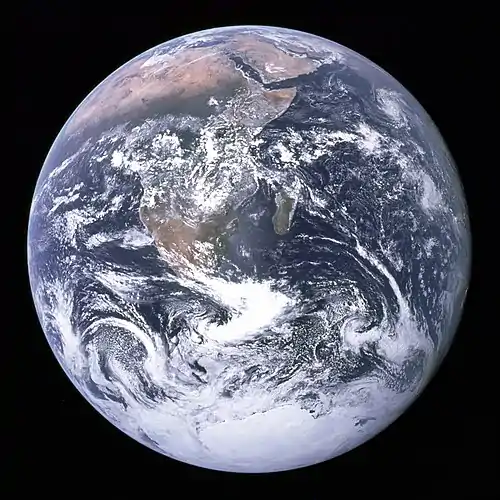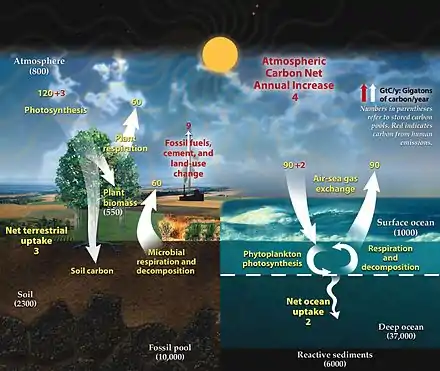Portal:Climate change
The Climate Change Portal Average surface air temperatures from 2011 to 2020 compared to the 1951-1980 average. Source: NASA. In common usage, climate change describes global warming—the ongoing increase in global average temperature—and its effects on Earth's climate system. Climate change in a broader sense also includes previous long-term changes to Earth's climate. The current rise in global average temperature is more rapid than previous changes, and is primarily caused by humans burning fossil fuels. Fossil fuel use, deforestation, and some agricultural and industrial practices increase greenhouse gases, notably carbon dioxide and methane. Greenhouse gases absorb some of the heat that the Earth radiates after it warms from sunlight. Larger amounts of these gases trap more heat in Earth's lower atmosphere, causing global warming. Due to climate change, deserts are expanding, while heat waves and wildfires are becoming more common. Increased warming in the Arctic has contributed to melting permafrost, glacial retreat and sea ice loss. Higher temperatures are also causing more intense storms, droughts, and other weather extremes. Rapid environmental change in mountains, coral reefs, and the Arctic is forcing many species to relocate or become extinct. Even if efforts to minimise future warming are successful, some effects will continue for centuries. These include ocean heating, ocean acidification and sea level rise. Climate change threatens people with increased flooding, extreme heat, increased food and water scarcity, more disease, and economic loss. Human migration and conflict can also be a result. The World Health Organization (WHO) calls climate change the greatest threat to global health in the 21st century. Societies and ecosystems will experience more severe risks in the future without action to limit warming. Adapting to climate change through efforts like flood control measures or drought-resistant crops reduces climate change risks, although this may not be possible with increasing warming. Poorer countries are responsible for a small share of global emissions, yet they have the least ability to adapt and are most vulnerable to climate change. Many climate change impacts are already felt at the current 1.2 °C (2.2 °F) level of warming. Additional warming will increase these impacts and can trigger tipping points, such as the melting of the Greenland ice sheet. Under the 2015 Paris Agreement, nations collectively agreed to keep warming "well under 2 °C". However, with pledges made under the Agreement, global warming would still reach about 2.7 °C (4.9 °F) by the end of the century. Limiting warming to 1.5 °C will require halving emissions by 2030 and achieving net-zero emissions by 2050. Reducing emissions requires generating electricity from low-carbon sources rather than burning fossil fuels. This change includes phasing out coal and natural gas fired power plants, vastly increasing use of wind, solar, and other types of renewable energy, and reducing energy use. Electricity generated from non-carbon-emitting sources will need to replace fossil fuels for powering transportation, heating buildings, and operating industrial facilities. Carbon can also be removed from the atmosphere, for instance by increasing forest cover and by farming with methods that capture carbon in soil. (Full article...) Selected article – The Kyoto Protocol was an international treaty which extended the 1992 United Nations Framework Convention on Climate Change (UNFCCC) that commits state parties to reduce greenhouse gas emissions, based on the scientific consensus that (part one) global warming is occurring and (part two) that human-made CO2 emissions are driving it. The Kyoto Protocol was adopted in Kyoto, Japan, on 11 December 1997 and entered into force on 16 February 2005. There were 192 parties (Canada withdrew from the protocol, effective December 2012) to the Protocol in 2020. The Kyoto Protocol implemented the objective of the UNFCCC to reduce the onset of global warming by reducing greenhouse gas concentrations in the atmosphere to "a level that would prevent dangerous anthropogenic interference with the climate system" (Article 2). The Kyoto Protocol applied to the seven greenhouse gases listed in Annex A: carbon dioxide (CO2), methane (CH4), nitrous oxide (N2O), hydrofluorocarbons (HFCs), perfluorocarbons (PFCs), sulfur hexafluoride (SF6), nitrogen trifluoride (NF3). Nitrogen trifluoride was added for the second compliance period during the Doha Round. The Protocol was based on the principle of common but differentiated responsibilities: it acknowledged that individual countries have different capabilities in combating climate change, owing to economic development, and therefore placed the obligation to reduce current emissions on developed countries on the basis that they are historically responsible for the current levels of greenhouse gases in the atmosphere. (Full article...)Selected picture – Credit: NASA The collapse of Larsen B Ice Shelf, showing the diminishing extent of the shelf from 1998 to 2002
WikiProjects
In the newsAdditional News
Selected biography –
(Full article...)
General imagesThe following are images from various climate-related articles on Wikipedia.
Did you know –Related portalsSelected panorama – Credit: U.S. Geological Survey – Northern Rocky Mountain Science Center (NOROCK) Authors: Myrna H. P. Hall and Daniel B. Fagre, 2003 Animation of Modeled Climate-Induced Glacier Change in Glacier National Park, 1850- 2100. The simulation reflects the predicted exponential rise in atmospheric carbon dioxide (CO2) concentrations, a 2xCO2 "global warming" scenario, with a concurrent warming of 2-3 degrees centigrade (4-5 degrees Fahrenheit) by the year 2050. In addition it assumes that precipitation, primarily in the form of rain, will increase over the same time period about 10 percent (based on the research of Dr. Steven Running, University of Montana).
TopicsCategoriesCategory puzzle Climate change Climate change by country and region Climate change-related lists Climate change assessment and attribution Climate change and the environment Climate change feedbacks Greenhouse gases Climate change litigation Climate change mitigation Climate change and society Climate change stubs Web resources
Things to do
WikimediaReferences
Discover Wikipedia using portals
|



















%252C_the_El_Ni%C3%B1o_%E2%80%93_Southern_Oscillation%252C_the_Arctic_Oscillation%252C_and_the_North_Atlantic_Oscillation_(NOAA).png.webp)










.png.webp)

.png.webp)











